A Report on Leadership, Cultural, and Performance Change at MeatPack
VerifiedAdded on 2023/04/26
|12
|3534
|280
Report
AI Summary
This report evaluates the case study on 'Leadership, Cultural, and Performance Change at MeatPack,' analyzing leadership styles, cultural shifts, and performance outcomes within the food processing company. It assesses the suitability of hands-on versus hands-off leadership approaches for the CEO, Derek Bison, considering factors like employee satisfaction and organizational goals. The report examines senior leadership changes, including the implementation of a Human Synergistic circumplex and ERP initiatives, and suggests improvements for the future. Furthermore, it explores the impact of MeatPack's flatter organizational structure on cultural and performance changes, identifying potential barriers and providing recommendations for fostering a positive and productive work environment. The analysis covers employee engagement, decision-making processes, and the importance of aligning leadership with strategic objectives to drive the company towards its goal of becoming a billion-dollar corporation.
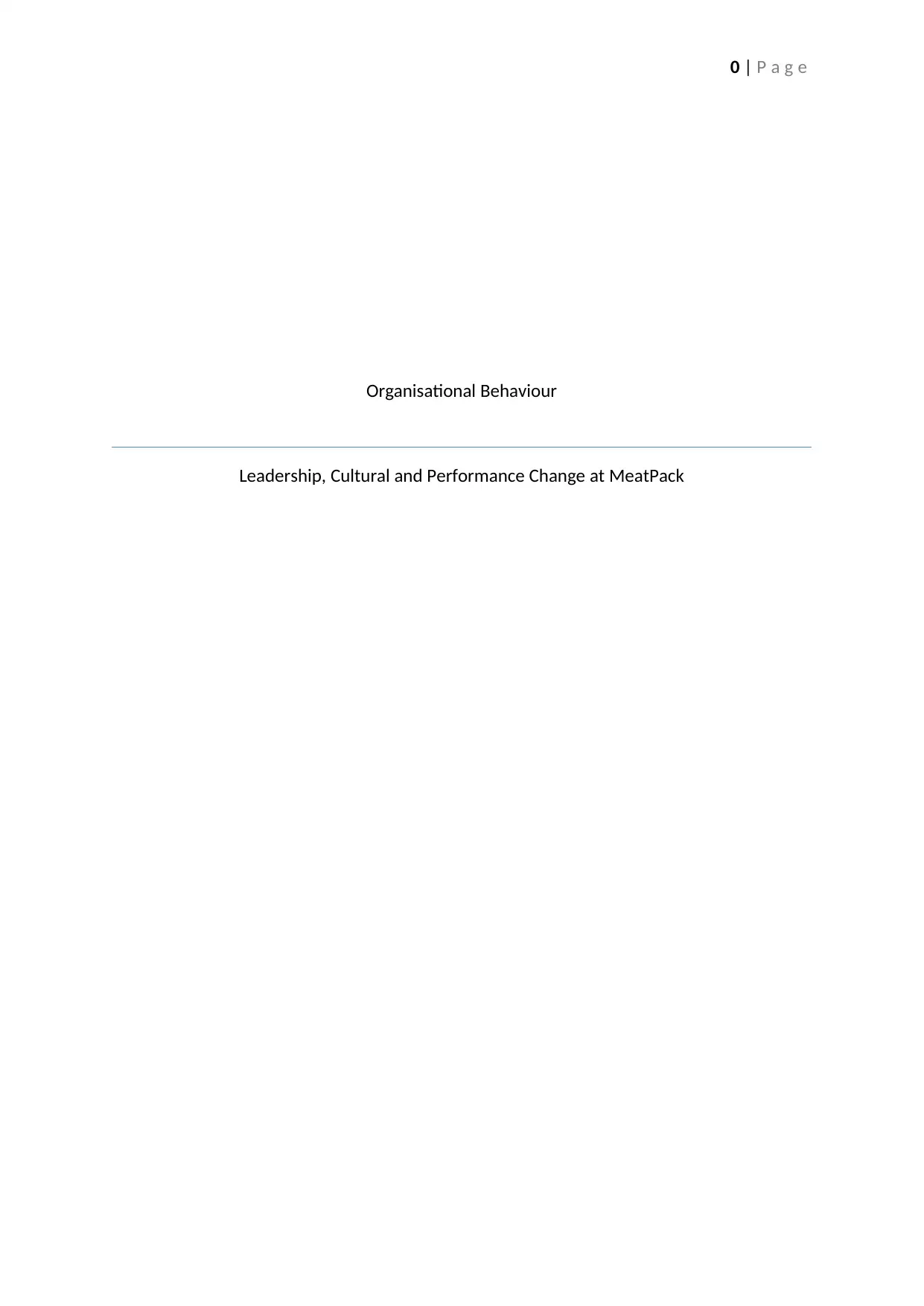
0 | P a g e
Organisational Behaviour
Leadership, Cultural and Performance Change at MeatPack
Organisational Behaviour
Leadership, Cultural and Performance Change at MeatPack
Paraphrase This Document
Need a fresh take? Get an instant paraphrase of this document with our AI Paraphraser
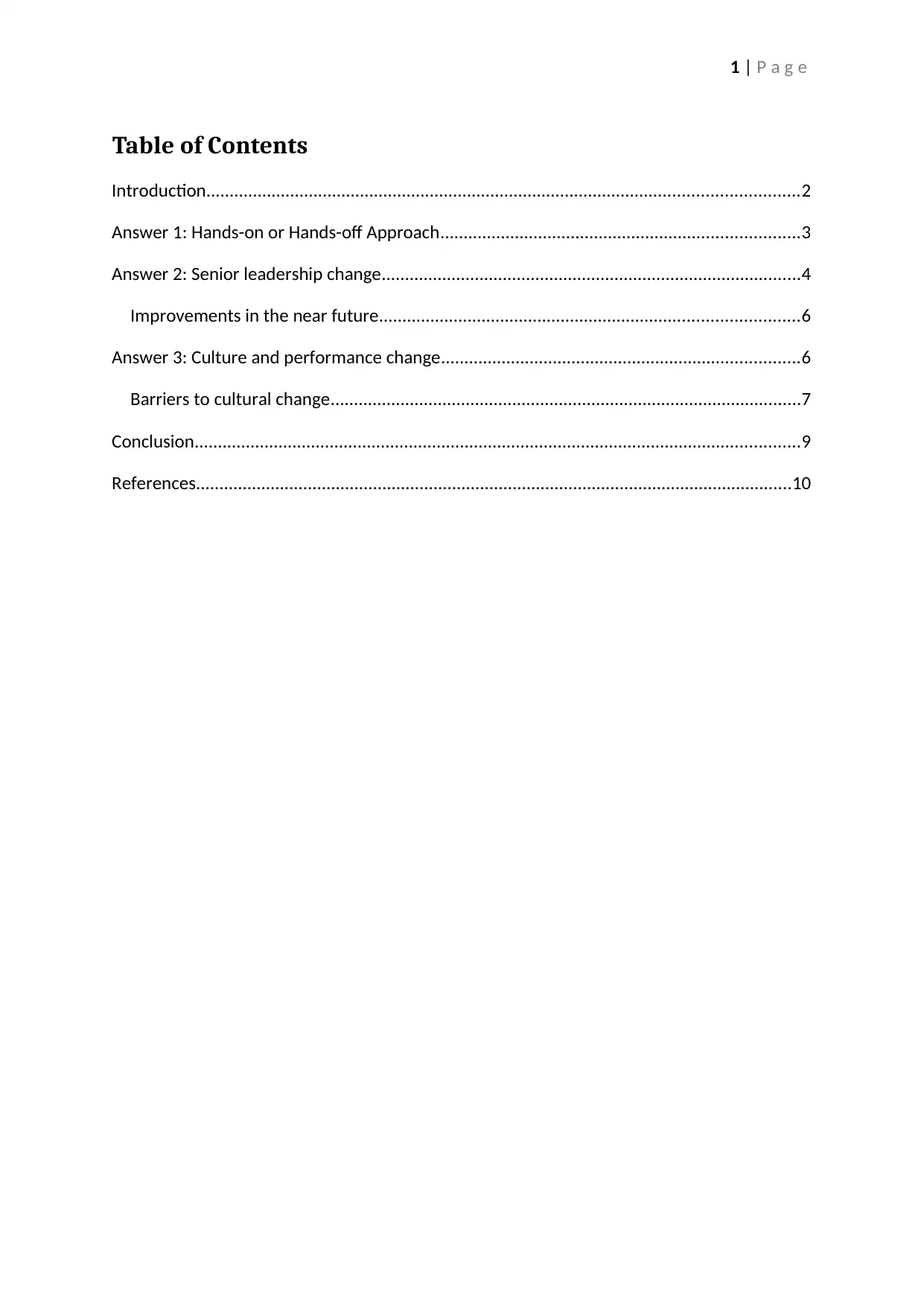
1 | P a g e
Table of Contents
Introduction...............................................................................................................................2
Answer 1: Hands-on or Hands-off Approach.............................................................................3
Answer 2: Senior leadership change..........................................................................................4
Improvements in the near future..........................................................................................6
Answer 3: Culture and performance change.............................................................................6
Barriers to cultural change.....................................................................................................7
Conclusion..................................................................................................................................9
References................................................................................................................................10
Table of Contents
Introduction...............................................................................................................................2
Answer 1: Hands-on or Hands-off Approach.............................................................................3
Answer 2: Senior leadership change..........................................................................................4
Improvements in the near future..........................................................................................6
Answer 3: Culture and performance change.............................................................................6
Barriers to cultural change.....................................................................................................7
Conclusion..................................................................................................................................9
References................................................................................................................................10
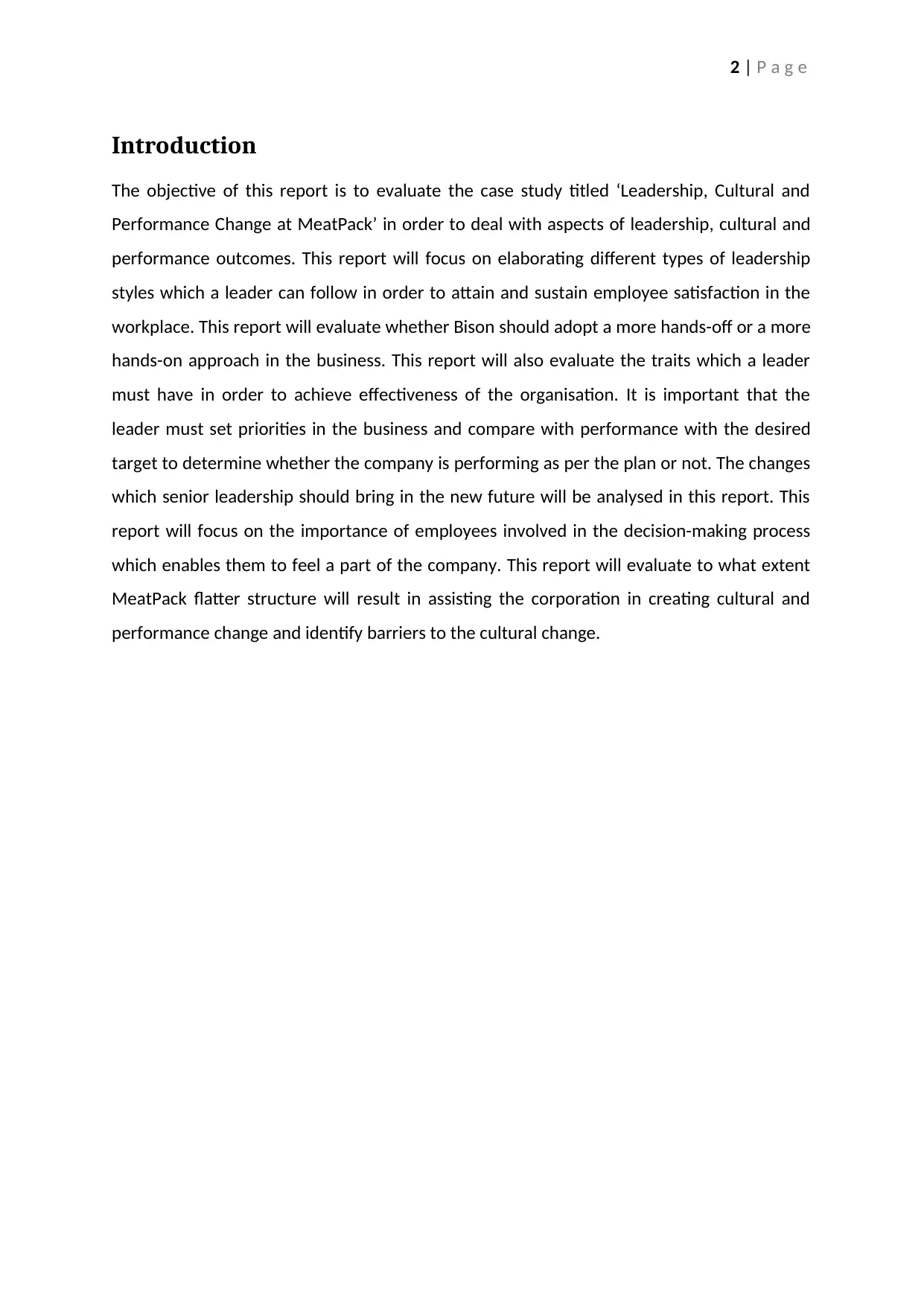
2 | P a g e
Introduction
The objective of this report is to evaluate the case study titled ‘Leadership, Cultural and
Performance Change at MeatPack’ in order to deal with aspects of leadership, cultural and
performance outcomes. This report will focus on elaborating different types of leadership
styles which a leader can follow in order to attain and sustain employee satisfaction in the
workplace. This report will evaluate whether Bison should adopt a more hands-off or a more
hands-on approach in the business. This report will also evaluate the traits which a leader
must have in order to achieve effectiveness of the organisation. It is important that the
leader must set priorities in the business and compare with performance with the desired
target to determine whether the company is performing as per the plan or not. The changes
which senior leadership should bring in the new future will be analysed in this report. This
report will focus on the importance of employees involved in the decision-making process
which enables them to feel a part of the company. This report will evaluate to what extent
MeatPack flatter structure will result in assisting the corporation in creating cultural and
performance change and identify barriers to the cultural change.
Introduction
The objective of this report is to evaluate the case study titled ‘Leadership, Cultural and
Performance Change at MeatPack’ in order to deal with aspects of leadership, cultural and
performance outcomes. This report will focus on elaborating different types of leadership
styles which a leader can follow in order to attain and sustain employee satisfaction in the
workplace. This report will evaluate whether Bison should adopt a more hands-off or a more
hands-on approach in the business. This report will also evaluate the traits which a leader
must have in order to achieve effectiveness of the organisation. It is important that the
leader must set priorities in the business and compare with performance with the desired
target to determine whether the company is performing as per the plan or not. The changes
which senior leadership should bring in the new future will be analysed in this report. This
report will focus on the importance of employees involved in the decision-making process
which enables them to feel a part of the company. This report will evaluate to what extent
MeatPack flatter structure will result in assisting the corporation in creating cultural and
performance change and identify barriers to the cultural change.
⊘ This is a preview!⊘
Do you want full access?
Subscribe today to unlock all pages.

Trusted by 1+ million students worldwide
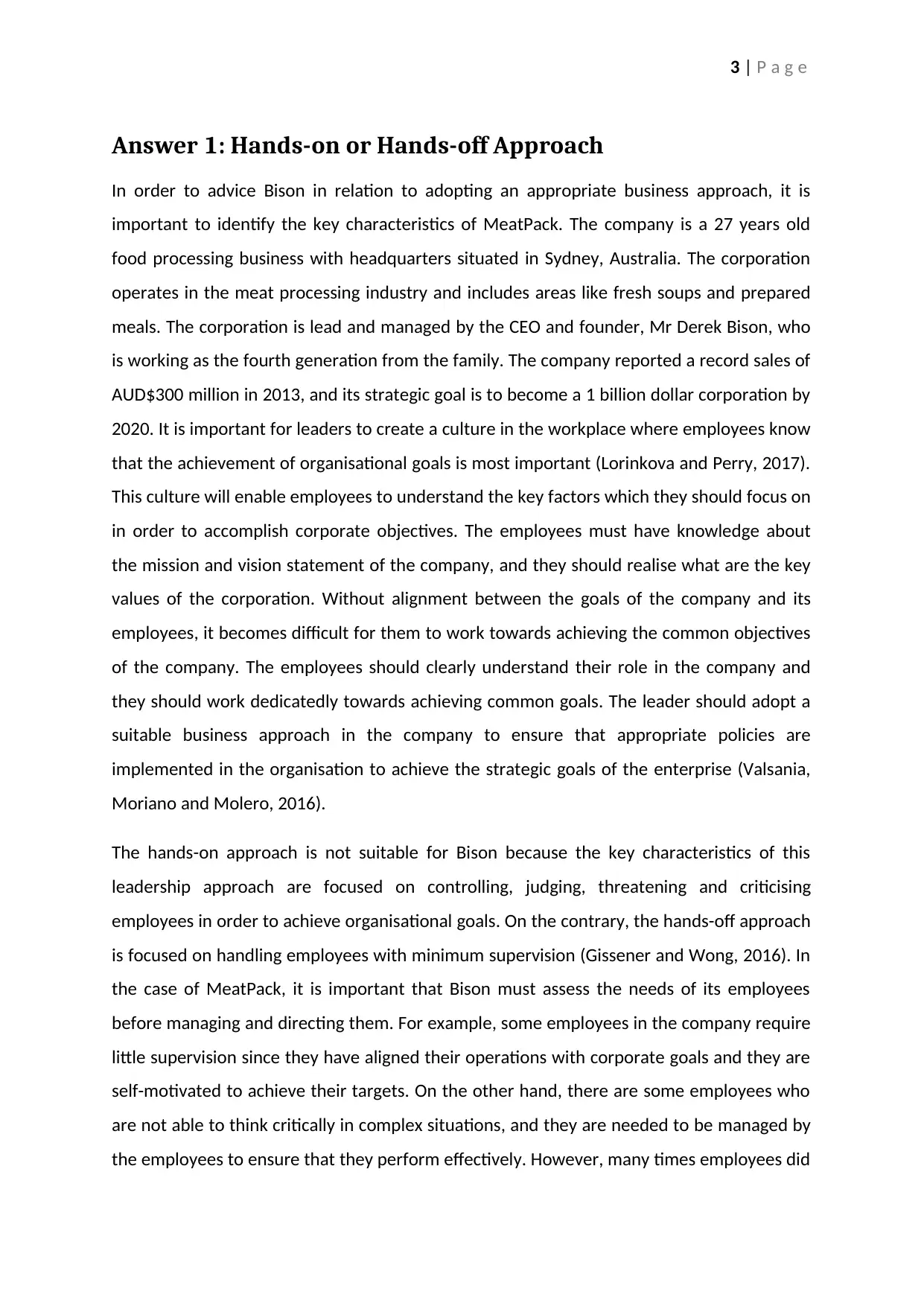
3 | P a g e
Answer 1: Hands-on or Hands-off Approach
In order to advice Bison in relation to adopting an appropriate business approach, it is
important to identify the key characteristics of MeatPack. The company is a 27 years old
food processing business with headquarters situated in Sydney, Australia. The corporation
operates in the meat processing industry and includes areas like fresh soups and prepared
meals. The corporation is lead and managed by the CEO and founder, Mr Derek Bison, who
is working as the fourth generation from the family. The company reported a record sales of
AUD$300 million in 2013, and its strategic goal is to become a 1 billion dollar corporation by
2020. It is important for leaders to create a culture in the workplace where employees know
that the achievement of organisational goals is most important (Lorinkova and Perry, 2017).
This culture will enable employees to understand the key factors which they should focus on
in order to accomplish corporate objectives. The employees must have knowledge about
the mission and vision statement of the company, and they should realise what are the key
values of the corporation. Without alignment between the goals of the company and its
employees, it becomes difficult for them to work towards achieving the common objectives
of the company. The employees should clearly understand their role in the company and
they should work dedicatedly towards achieving common goals. The leader should adopt a
suitable business approach in the company to ensure that appropriate policies are
implemented in the organisation to achieve the strategic goals of the enterprise (Valsania,
Moriano and Molero, 2016).
The hands-on approach is not suitable for Bison because the key characteristics of this
leadership approach are focused on controlling, judging, threatening and criticising
employees in order to achieve organisational goals. On the contrary, the hands-off approach
is focused on handling employees with minimum supervision (Gissener and Wong, 2016). In
the case of MeatPack, it is important that Bison must assess the needs of its employees
before managing and directing them. For example, some employees in the company require
little supervision since they have aligned their operations with corporate goals and they are
self-motivated to achieve their targets. On the other hand, there are some employees who
are not able to think critically in complex situations, and they are needed to be managed by
the employees to ensure that they perform effectively. However, many times employees did
Answer 1: Hands-on or Hands-off Approach
In order to advice Bison in relation to adopting an appropriate business approach, it is
important to identify the key characteristics of MeatPack. The company is a 27 years old
food processing business with headquarters situated in Sydney, Australia. The corporation
operates in the meat processing industry and includes areas like fresh soups and prepared
meals. The corporation is lead and managed by the CEO and founder, Mr Derek Bison, who
is working as the fourth generation from the family. The company reported a record sales of
AUD$300 million in 2013, and its strategic goal is to become a 1 billion dollar corporation by
2020. It is important for leaders to create a culture in the workplace where employees know
that the achievement of organisational goals is most important (Lorinkova and Perry, 2017).
This culture will enable employees to understand the key factors which they should focus on
in order to accomplish corporate objectives. The employees must have knowledge about
the mission and vision statement of the company, and they should realise what are the key
values of the corporation. Without alignment between the goals of the company and its
employees, it becomes difficult for them to work towards achieving the common objectives
of the company. The employees should clearly understand their role in the company and
they should work dedicatedly towards achieving common goals. The leader should adopt a
suitable business approach in the company to ensure that appropriate policies are
implemented in the organisation to achieve the strategic goals of the enterprise (Valsania,
Moriano and Molero, 2016).
The hands-on approach is not suitable for Bison because the key characteristics of this
leadership approach are focused on controlling, judging, threatening and criticising
employees in order to achieve organisational goals. On the contrary, the hands-off approach
is focused on handling employees with minimum supervision (Gissener and Wong, 2016). In
the case of MeatPack, it is important that Bison must assess the needs of its employees
before managing and directing them. For example, some employees in the company require
little supervision since they have aligned their operations with corporate goals and they are
self-motivated to achieve their targets. On the other hand, there are some employees who
are not able to think critically in complex situations, and they are needed to be managed by
the employees to ensure that they perform effectively. However, many times employees did
Paraphrase This Document
Need a fresh take? Get an instant paraphrase of this document with our AI Paraphraser
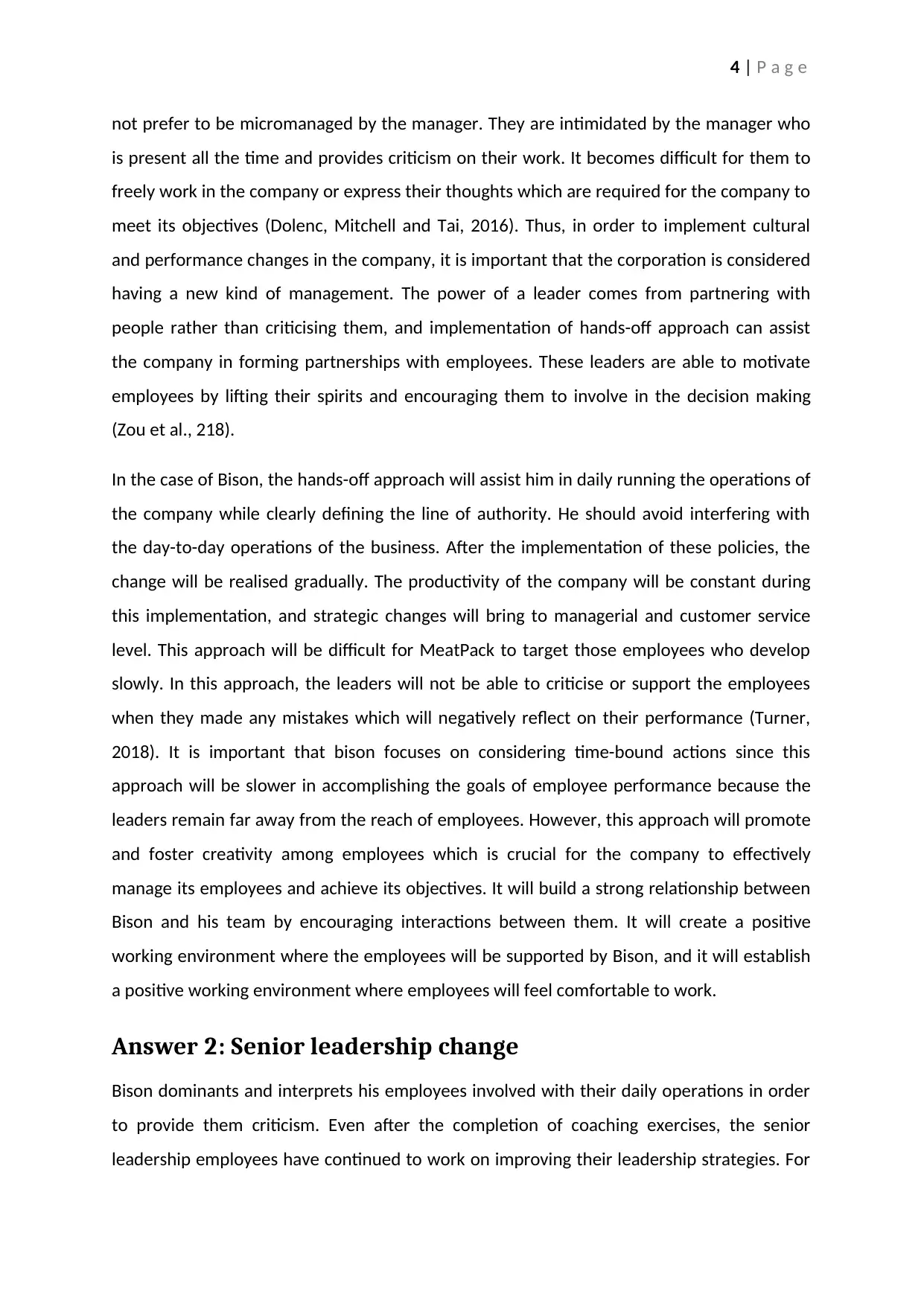
4 | P a g e
not prefer to be micromanaged by the manager. They are intimidated by the manager who
is present all the time and provides criticism on their work. It becomes difficult for them to
freely work in the company or express their thoughts which are required for the company to
meet its objectives (Dolenc, Mitchell and Tai, 2016). Thus, in order to implement cultural
and performance changes in the company, it is important that the corporation is considered
having a new kind of management. The power of a leader comes from partnering with
people rather than criticising them, and implementation of hands-off approach can assist
the company in forming partnerships with employees. These leaders are able to motivate
employees by lifting their spirits and encouraging them to involve in the decision making
(Zou et al., 218).
In the case of Bison, the hands-off approach will assist him in daily running the operations of
the company while clearly defining the line of authority. He should avoid interfering with
the day-to-day operations of the business. After the implementation of these policies, the
change will be realised gradually. The productivity of the company will be constant during
this implementation, and strategic changes will bring to managerial and customer service
level. This approach will be difficult for MeatPack to target those employees who develop
slowly. In this approach, the leaders will not be able to criticise or support the employees
when they made any mistakes which will negatively reflect on their performance (Turner,
2018). It is important that bison focuses on considering time-bound actions since this
approach will be slower in accomplishing the goals of employee performance because the
leaders remain far away from the reach of employees. However, this approach will promote
and foster creativity among employees which is crucial for the company to effectively
manage its employees and achieve its objectives. It will build a strong relationship between
Bison and his team by encouraging interactions between them. It will create a positive
working environment where the employees will be supported by Bison, and it will establish
a positive working environment where employees will feel comfortable to work.
Answer 2: Senior leadership change
Bison dominants and interprets his employees involved with their daily operations in order
to provide them criticism. Even after the completion of coaching exercises, the senior
leadership employees have continued to work on improving their leadership strategies. For
not prefer to be micromanaged by the manager. They are intimidated by the manager who
is present all the time and provides criticism on their work. It becomes difficult for them to
freely work in the company or express their thoughts which are required for the company to
meet its objectives (Dolenc, Mitchell and Tai, 2016). Thus, in order to implement cultural
and performance changes in the company, it is important that the corporation is considered
having a new kind of management. The power of a leader comes from partnering with
people rather than criticising them, and implementation of hands-off approach can assist
the company in forming partnerships with employees. These leaders are able to motivate
employees by lifting their spirits and encouraging them to involve in the decision making
(Zou et al., 218).
In the case of Bison, the hands-off approach will assist him in daily running the operations of
the company while clearly defining the line of authority. He should avoid interfering with
the day-to-day operations of the business. After the implementation of these policies, the
change will be realised gradually. The productivity of the company will be constant during
this implementation, and strategic changes will bring to managerial and customer service
level. This approach will be difficult for MeatPack to target those employees who develop
slowly. In this approach, the leaders will not be able to criticise or support the employees
when they made any mistakes which will negatively reflect on their performance (Turner,
2018). It is important that bison focuses on considering time-bound actions since this
approach will be slower in accomplishing the goals of employee performance because the
leaders remain far away from the reach of employees. However, this approach will promote
and foster creativity among employees which is crucial for the company to effectively
manage its employees and achieve its objectives. It will build a strong relationship between
Bison and his team by encouraging interactions between them. It will create a positive
working environment where the employees will be supported by Bison, and it will establish
a positive working environment where employees will feel comfortable to work.
Answer 2: Senior leadership change
Bison dominants and interprets his employees involved with their daily operations in order
to provide them criticism. Even after the completion of coaching exercises, the senior
leadership employees have continued to work on improving their leadership strategies. For
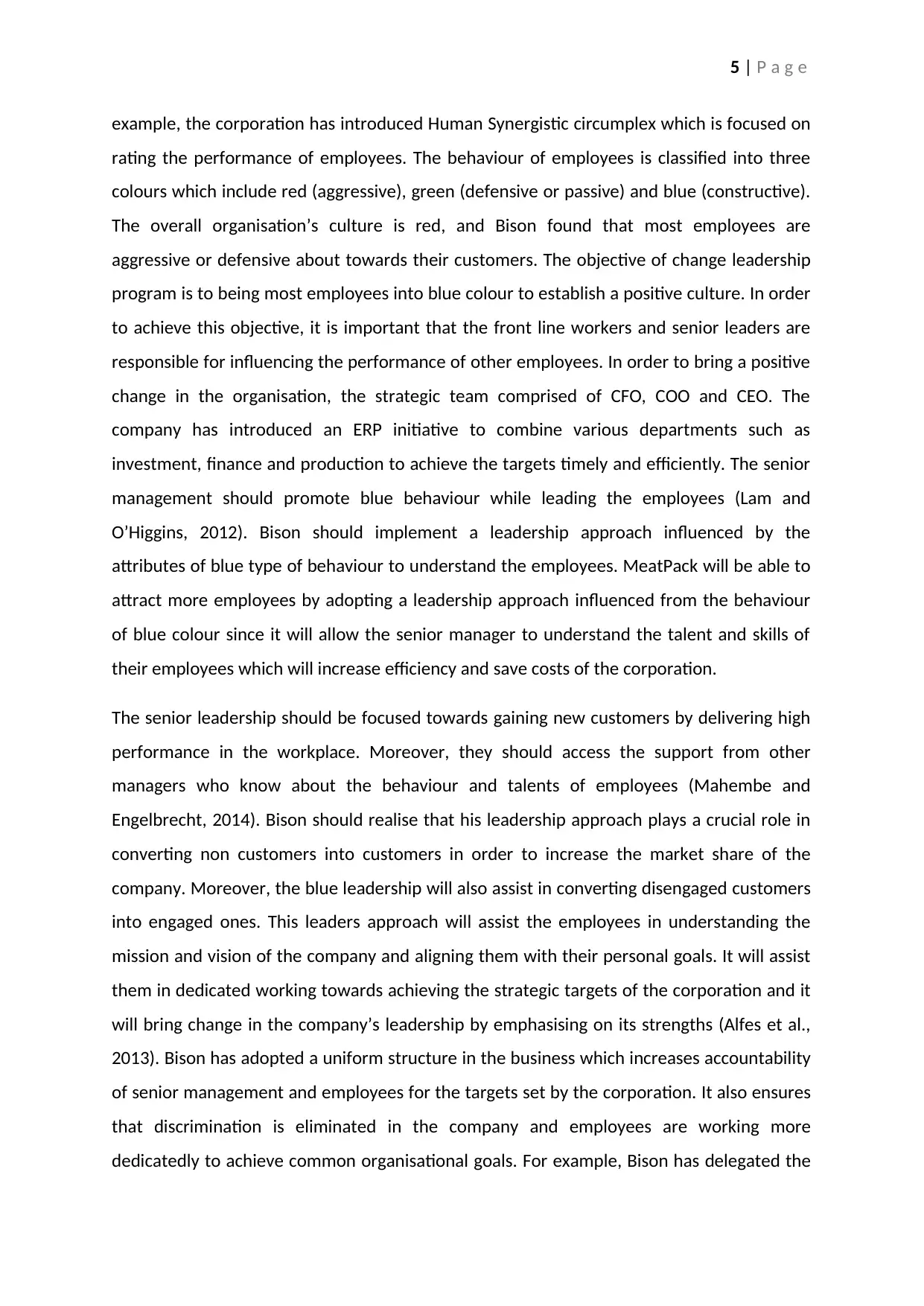
5 | P a g e
example, the corporation has introduced Human Synergistic circumplex which is focused on
rating the performance of employees. The behaviour of employees is classified into three
colours which include red (aggressive), green (defensive or passive) and blue (constructive).
The overall organisation’s culture is red, and Bison found that most employees are
aggressive or defensive about towards their customers. The objective of change leadership
program is to being most employees into blue colour to establish a positive culture. In order
to achieve this objective, it is important that the front line workers and senior leaders are
responsible for influencing the performance of other employees. In order to bring a positive
change in the organisation, the strategic team comprised of CFO, COO and CEO. The
company has introduced an ERP initiative to combine various departments such as
investment, finance and production to achieve the targets timely and efficiently. The senior
management should promote blue behaviour while leading the employees (Lam and
O’Higgins, 2012). Bison should implement a leadership approach influenced by the
attributes of blue type of behaviour to understand the employees. MeatPack will be able to
attract more employees by adopting a leadership approach influenced from the behaviour
of blue colour since it will allow the senior manager to understand the talent and skills of
their employees which will increase efficiency and save costs of the corporation.
The senior leadership should be focused towards gaining new customers by delivering high
performance in the workplace. Moreover, they should access the support from other
managers who know about the behaviour and talents of employees (Mahembe and
Engelbrecht, 2014). Bison should realise that his leadership approach plays a crucial role in
converting non customers into customers in order to increase the market share of the
company. Moreover, the blue leadership will also assist in converting disengaged customers
into engaged ones. This leaders approach will assist the employees in understanding the
mission and vision of the company and aligning them with their personal goals. It will assist
them in dedicated working towards achieving the strategic targets of the corporation and it
will bring change in the company’s leadership by emphasising on its strengths (Alfes et al.,
2013). Bison has adopted a uniform structure in the business which increases accountability
of senior management and employees for the targets set by the corporation. It also ensures
that discrimination is eliminated in the company and employees are working more
dedicatedly to achieve common organisational goals. For example, Bison has delegated the
example, the corporation has introduced Human Synergistic circumplex which is focused on
rating the performance of employees. The behaviour of employees is classified into three
colours which include red (aggressive), green (defensive or passive) and blue (constructive).
The overall organisation’s culture is red, and Bison found that most employees are
aggressive or defensive about towards their customers. The objective of change leadership
program is to being most employees into blue colour to establish a positive culture. In order
to achieve this objective, it is important that the front line workers and senior leaders are
responsible for influencing the performance of other employees. In order to bring a positive
change in the organisation, the strategic team comprised of CFO, COO and CEO. The
company has introduced an ERP initiative to combine various departments such as
investment, finance and production to achieve the targets timely and efficiently. The senior
management should promote blue behaviour while leading the employees (Lam and
O’Higgins, 2012). Bison should implement a leadership approach influenced by the
attributes of blue type of behaviour to understand the employees. MeatPack will be able to
attract more employees by adopting a leadership approach influenced from the behaviour
of blue colour since it will allow the senior manager to understand the talent and skills of
their employees which will increase efficiency and save costs of the corporation.
The senior leadership should be focused towards gaining new customers by delivering high
performance in the workplace. Moreover, they should access the support from other
managers who know about the behaviour and talents of employees (Mahembe and
Engelbrecht, 2014). Bison should realise that his leadership approach plays a crucial role in
converting non customers into customers in order to increase the market share of the
company. Moreover, the blue leadership will also assist in converting disengaged customers
into engaged ones. This leaders approach will assist the employees in understanding the
mission and vision of the company and aligning them with their personal goals. It will assist
them in dedicated working towards achieving the strategic targets of the corporation and it
will bring change in the company’s leadership by emphasising on its strengths (Alfes et al.,
2013). Bison has adopted a uniform structure in the business which increases accountability
of senior management and employees for the targets set by the corporation. It also ensures
that discrimination is eliminated in the company and employees are working more
dedicatedly to achieve common organisational goals. For example, Bison has delegated the
⊘ This is a preview!⊘
Do you want full access?
Subscribe today to unlock all pages.

Trusted by 1+ million students worldwide
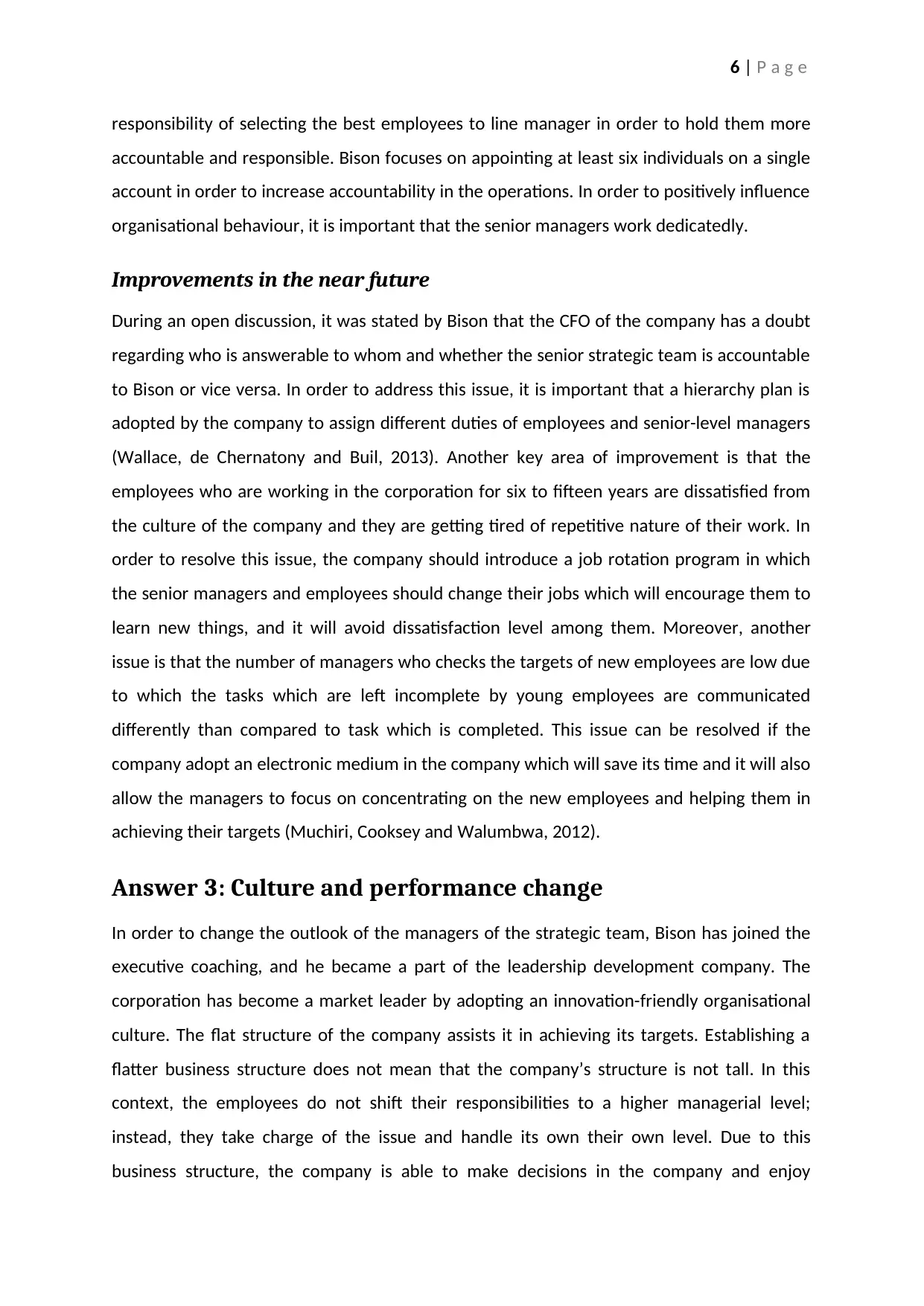
6 | P a g e
responsibility of selecting the best employees to line manager in order to hold them more
accountable and responsible. Bison focuses on appointing at least six individuals on a single
account in order to increase accountability in the operations. In order to positively influence
organisational behaviour, it is important that the senior managers work dedicatedly.
Improvements in the near future
During an open discussion, it was stated by Bison that the CFO of the company has a doubt
regarding who is answerable to whom and whether the senior strategic team is accountable
to Bison or vice versa. In order to address this issue, it is important that a hierarchy plan is
adopted by the company to assign different duties of employees and senior-level managers
(Wallace, de Chernatony and Buil, 2013). Another key area of improvement is that the
employees who are working in the corporation for six to fifteen years are dissatisfied from
the culture of the company and they are getting tired of repetitive nature of their work. In
order to resolve this issue, the company should introduce a job rotation program in which
the senior managers and employees should change their jobs which will encourage them to
learn new things, and it will avoid dissatisfaction level among them. Moreover, another
issue is that the number of managers who checks the targets of new employees are low due
to which the tasks which are left incomplete by young employees are communicated
differently than compared to task which is completed. This issue can be resolved if the
company adopt an electronic medium in the company which will save its time and it will also
allow the managers to focus on concentrating on the new employees and helping them in
achieving their targets (Muchiri, Cooksey and Walumbwa, 2012).
Answer 3: Culture and performance change
In order to change the outlook of the managers of the strategic team, Bison has joined the
executive coaching, and he became a part of the leadership development company. The
corporation has become a market leader by adopting an innovation-friendly organisational
culture. The flat structure of the company assists it in achieving its targets. Establishing a
flatter business structure does not mean that the company’s structure is not tall. In this
context, the employees do not shift their responsibilities to a higher managerial level;
instead, they take charge of the issue and handle its own their own level. Due to this
business structure, the company is able to make decisions in the company and enjoy
responsibility of selecting the best employees to line manager in order to hold them more
accountable and responsible. Bison focuses on appointing at least six individuals on a single
account in order to increase accountability in the operations. In order to positively influence
organisational behaviour, it is important that the senior managers work dedicatedly.
Improvements in the near future
During an open discussion, it was stated by Bison that the CFO of the company has a doubt
regarding who is answerable to whom and whether the senior strategic team is accountable
to Bison or vice versa. In order to address this issue, it is important that a hierarchy plan is
adopted by the company to assign different duties of employees and senior-level managers
(Wallace, de Chernatony and Buil, 2013). Another key area of improvement is that the
employees who are working in the corporation for six to fifteen years are dissatisfied from
the culture of the company and they are getting tired of repetitive nature of their work. In
order to resolve this issue, the company should introduce a job rotation program in which
the senior managers and employees should change their jobs which will encourage them to
learn new things, and it will avoid dissatisfaction level among them. Moreover, another
issue is that the number of managers who checks the targets of new employees are low due
to which the tasks which are left incomplete by young employees are communicated
differently than compared to task which is completed. This issue can be resolved if the
company adopt an electronic medium in the company which will save its time and it will also
allow the managers to focus on concentrating on the new employees and helping them in
achieving their targets (Muchiri, Cooksey and Walumbwa, 2012).
Answer 3: Culture and performance change
In order to change the outlook of the managers of the strategic team, Bison has joined the
executive coaching, and he became a part of the leadership development company. The
corporation has become a market leader by adopting an innovation-friendly organisational
culture. The flat structure of the company assists it in achieving its targets. Establishing a
flatter business structure does not mean that the company’s structure is not tall. In this
context, the employees do not shift their responsibilities to a higher managerial level;
instead, they take charge of the issue and handle its own their own level. Due to this
business structure, the company is able to make decisions in the company and enjoy
Paraphrase This Document
Need a fresh take? Get an instant paraphrase of this document with our AI Paraphraser
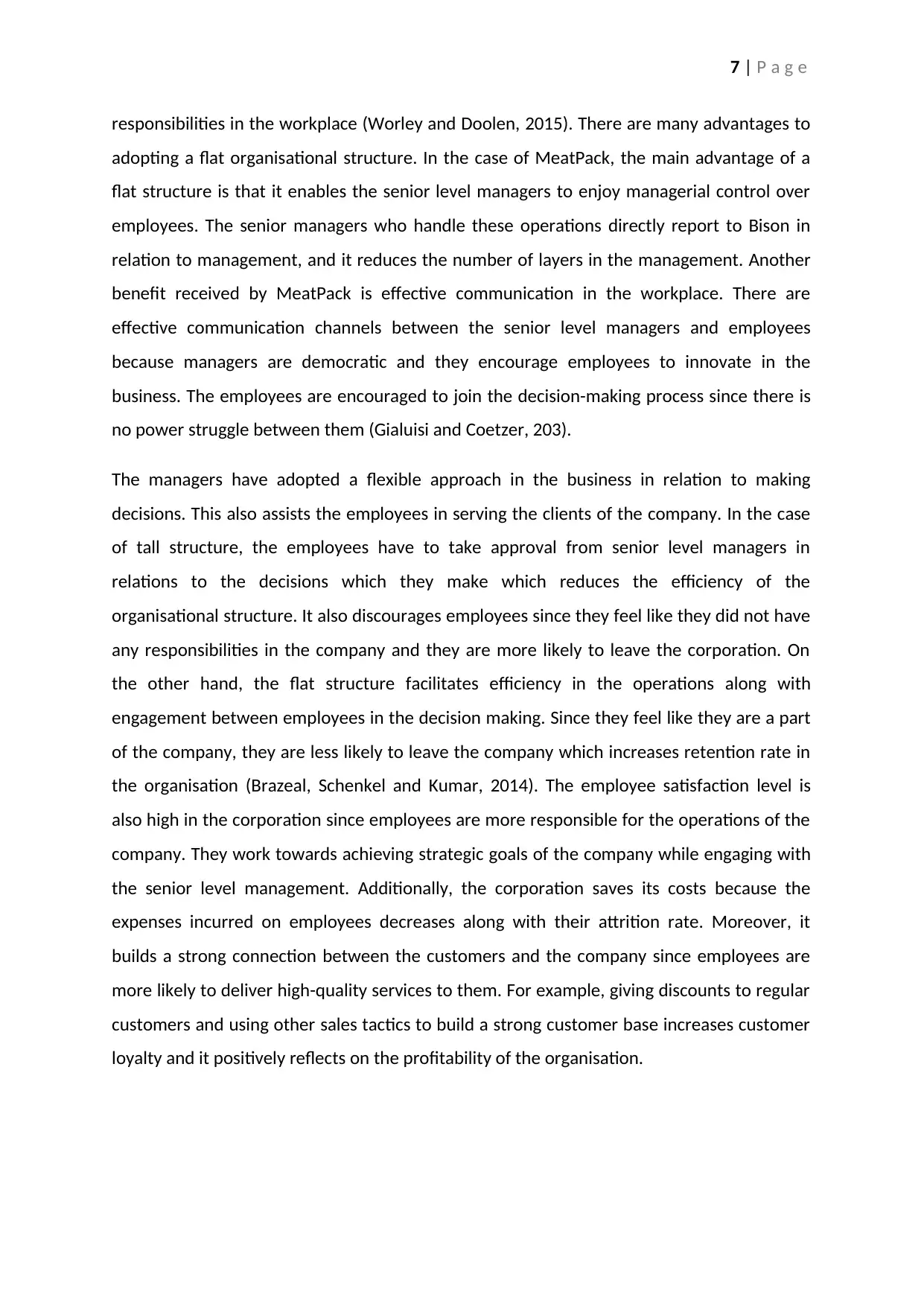
7 | P a g e
responsibilities in the workplace (Worley and Doolen, 2015). There are many advantages to
adopting a flat organisational structure. In the case of MeatPack, the main advantage of a
flat structure is that it enables the senior level managers to enjoy managerial control over
employees. The senior managers who handle these operations directly report to Bison in
relation to management, and it reduces the number of layers in the management. Another
benefit received by MeatPack is effective communication in the workplace. There are
effective communication channels between the senior level managers and employees
because managers are democratic and they encourage employees to innovate in the
business. The employees are encouraged to join the decision-making process since there is
no power struggle between them (Gialuisi and Coetzer, 203).
The managers have adopted a flexible approach in the business in relation to making
decisions. This also assists the employees in serving the clients of the company. In the case
of tall structure, the employees have to take approval from senior level managers in
relations to the decisions which they make which reduces the efficiency of the
organisational structure. It also discourages employees since they feel like they did not have
any responsibilities in the company and they are more likely to leave the corporation. On
the other hand, the flat structure facilitates efficiency in the operations along with
engagement between employees in the decision making. Since they feel like they are a part
of the company, they are less likely to leave the company which increases retention rate in
the organisation (Brazeal, Schenkel and Kumar, 2014). The employee satisfaction level is
also high in the corporation since employees are more responsible for the operations of the
company. They work towards achieving strategic goals of the company while engaging with
the senior level management. Additionally, the corporation saves its costs because the
expenses incurred on employees decreases along with their attrition rate. Moreover, it
builds a strong connection between the customers and the company since employees are
more likely to deliver high-quality services to them. For example, giving discounts to regular
customers and using other sales tactics to build a strong customer base increases customer
loyalty and it positively reflects on the profitability of the organisation.
responsibilities in the workplace (Worley and Doolen, 2015). There are many advantages to
adopting a flat organisational structure. In the case of MeatPack, the main advantage of a
flat structure is that it enables the senior level managers to enjoy managerial control over
employees. The senior managers who handle these operations directly report to Bison in
relation to management, and it reduces the number of layers in the management. Another
benefit received by MeatPack is effective communication in the workplace. There are
effective communication channels between the senior level managers and employees
because managers are democratic and they encourage employees to innovate in the
business. The employees are encouraged to join the decision-making process since there is
no power struggle between them (Gialuisi and Coetzer, 203).
The managers have adopted a flexible approach in the business in relation to making
decisions. This also assists the employees in serving the clients of the company. In the case
of tall structure, the employees have to take approval from senior level managers in
relations to the decisions which they make which reduces the efficiency of the
organisational structure. It also discourages employees since they feel like they did not have
any responsibilities in the company and they are more likely to leave the corporation. On
the other hand, the flat structure facilitates efficiency in the operations along with
engagement between employees in the decision making. Since they feel like they are a part
of the company, they are less likely to leave the company which increases retention rate in
the organisation (Brazeal, Schenkel and Kumar, 2014). The employee satisfaction level is
also high in the corporation since employees are more responsible for the operations of the
company. They work towards achieving strategic goals of the company while engaging with
the senior level management. Additionally, the corporation saves its costs because the
expenses incurred on employees decreases along with their attrition rate. Moreover, it
builds a strong connection between the customers and the company since employees are
more likely to deliver high-quality services to them. For example, giving discounts to regular
customers and using other sales tactics to build a strong customer base increases customer
loyalty and it positively reflects on the profitability of the organisation.
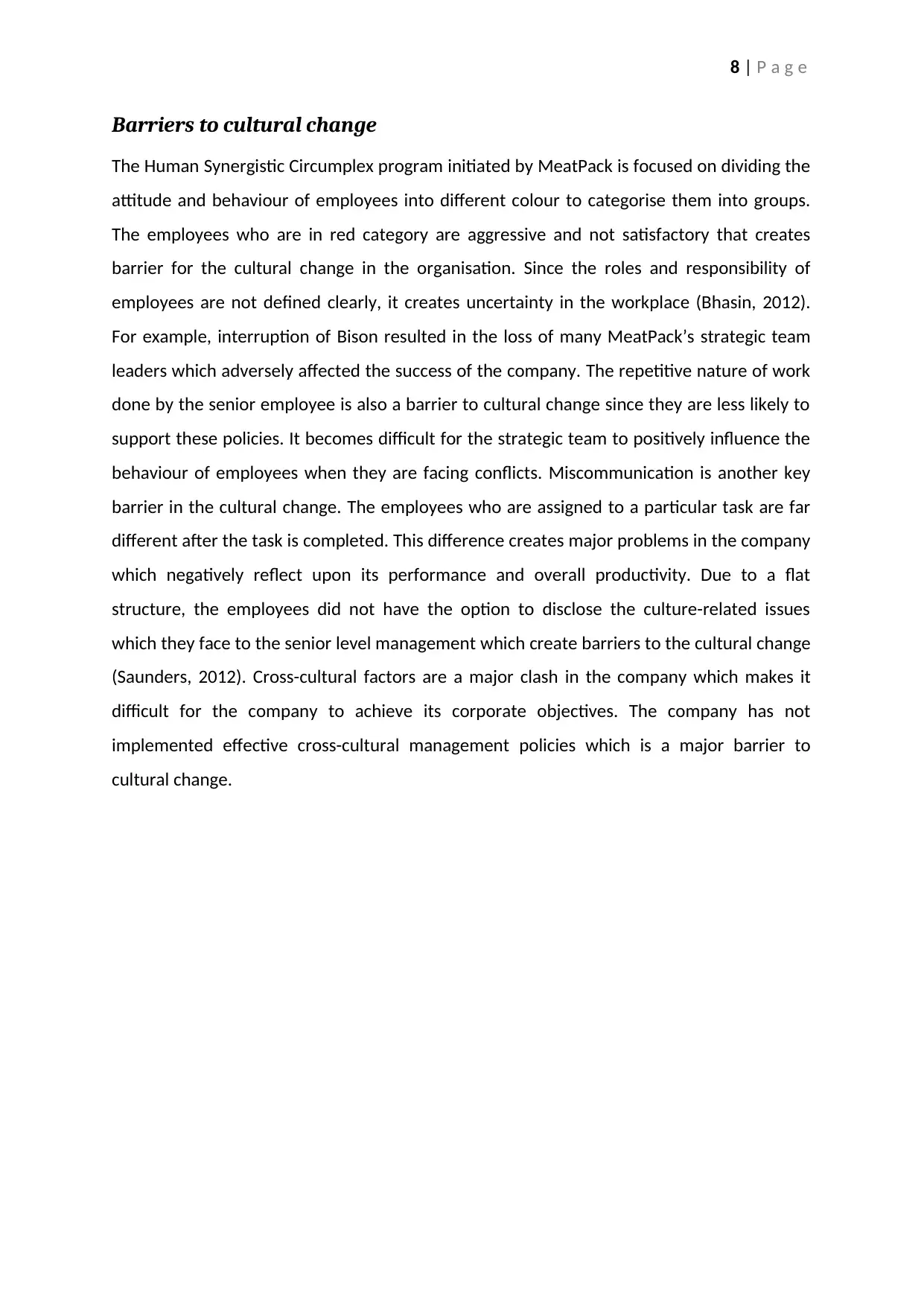
8 | P a g e
Barriers to cultural change
The Human Synergistic Circumplex program initiated by MeatPack is focused on dividing the
attitude and behaviour of employees into different colour to categorise them into groups.
The employees who are in red category are aggressive and not satisfactory that creates
barrier for the cultural change in the organisation. Since the roles and responsibility of
employees are not defined clearly, it creates uncertainty in the workplace (Bhasin, 2012).
For example, interruption of Bison resulted in the loss of many MeatPack’s strategic team
leaders which adversely affected the success of the company. The repetitive nature of work
done by the senior employee is also a barrier to cultural change since they are less likely to
support these policies. It becomes difficult for the strategic team to positively influence the
behaviour of employees when they are facing conflicts. Miscommunication is another key
barrier in the cultural change. The employees who are assigned to a particular task are far
different after the task is completed. This difference creates major problems in the company
which negatively reflect upon its performance and overall productivity. Due to a flat
structure, the employees did not have the option to disclose the culture-related issues
which they face to the senior level management which create barriers to the cultural change
(Saunders, 2012). Cross-cultural factors are a major clash in the company which makes it
difficult for the company to achieve its corporate objectives. The company has not
implemented effective cross-cultural management policies which is a major barrier to
cultural change.
Barriers to cultural change
The Human Synergistic Circumplex program initiated by MeatPack is focused on dividing the
attitude and behaviour of employees into different colour to categorise them into groups.
The employees who are in red category are aggressive and not satisfactory that creates
barrier for the cultural change in the organisation. Since the roles and responsibility of
employees are not defined clearly, it creates uncertainty in the workplace (Bhasin, 2012).
For example, interruption of Bison resulted in the loss of many MeatPack’s strategic team
leaders which adversely affected the success of the company. The repetitive nature of work
done by the senior employee is also a barrier to cultural change since they are less likely to
support these policies. It becomes difficult for the strategic team to positively influence the
behaviour of employees when they are facing conflicts. Miscommunication is another key
barrier in the cultural change. The employees who are assigned to a particular task are far
different after the task is completed. This difference creates major problems in the company
which negatively reflect upon its performance and overall productivity. Due to a flat
structure, the employees did not have the option to disclose the culture-related issues
which they face to the senior level management which create barriers to the cultural change
(Saunders, 2012). Cross-cultural factors are a major clash in the company which makes it
difficult for the company to achieve its corporate objectives. The company has not
implemented effective cross-cultural management policies which is a major barrier to
cultural change.
⊘ This is a preview!⊘
Do you want full access?
Subscribe today to unlock all pages.

Trusted by 1+ million students worldwide
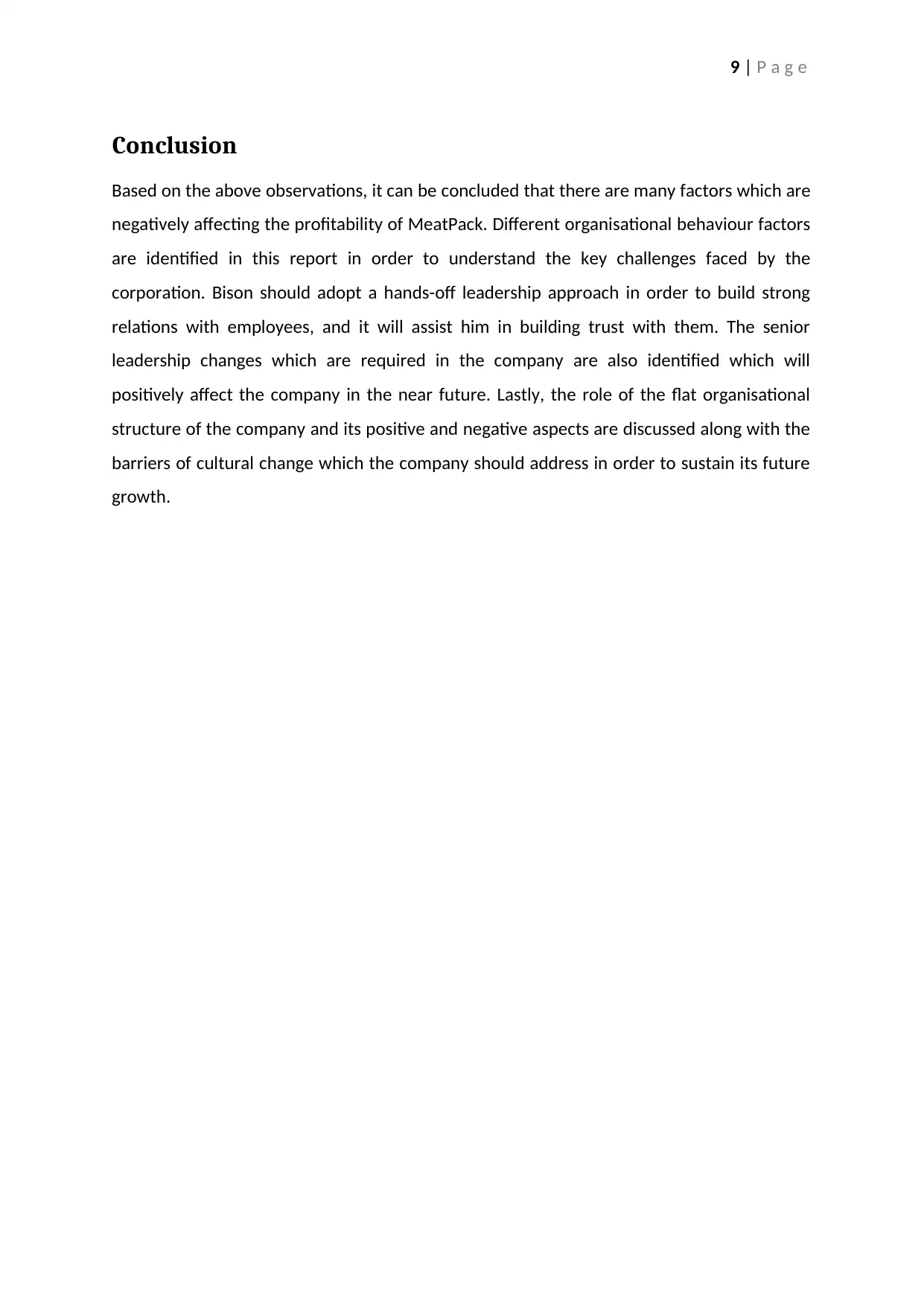
9 | P a g e
Conclusion
Based on the above observations, it can be concluded that there are many factors which are
negatively affecting the profitability of MeatPack. Different organisational behaviour factors
are identified in this report in order to understand the key challenges faced by the
corporation. Bison should adopt a hands-off leadership approach in order to build strong
relations with employees, and it will assist him in building trust with them. The senior
leadership changes which are required in the company are also identified which will
positively affect the company in the near future. Lastly, the role of the flat organisational
structure of the company and its positive and negative aspects are discussed along with the
barriers of cultural change which the company should address in order to sustain its future
growth.
Conclusion
Based on the above observations, it can be concluded that there are many factors which are
negatively affecting the profitability of MeatPack. Different organisational behaviour factors
are identified in this report in order to understand the key challenges faced by the
corporation. Bison should adopt a hands-off leadership approach in order to build strong
relations with employees, and it will assist him in building trust with them. The senior
leadership changes which are required in the company are also identified which will
positively affect the company in the near future. Lastly, the role of the flat organisational
structure of the company and its positive and negative aspects are discussed along with the
barriers of cultural change which the company should address in order to sustain its future
growth.
Paraphrase This Document
Need a fresh take? Get an instant paraphrase of this document with our AI Paraphraser
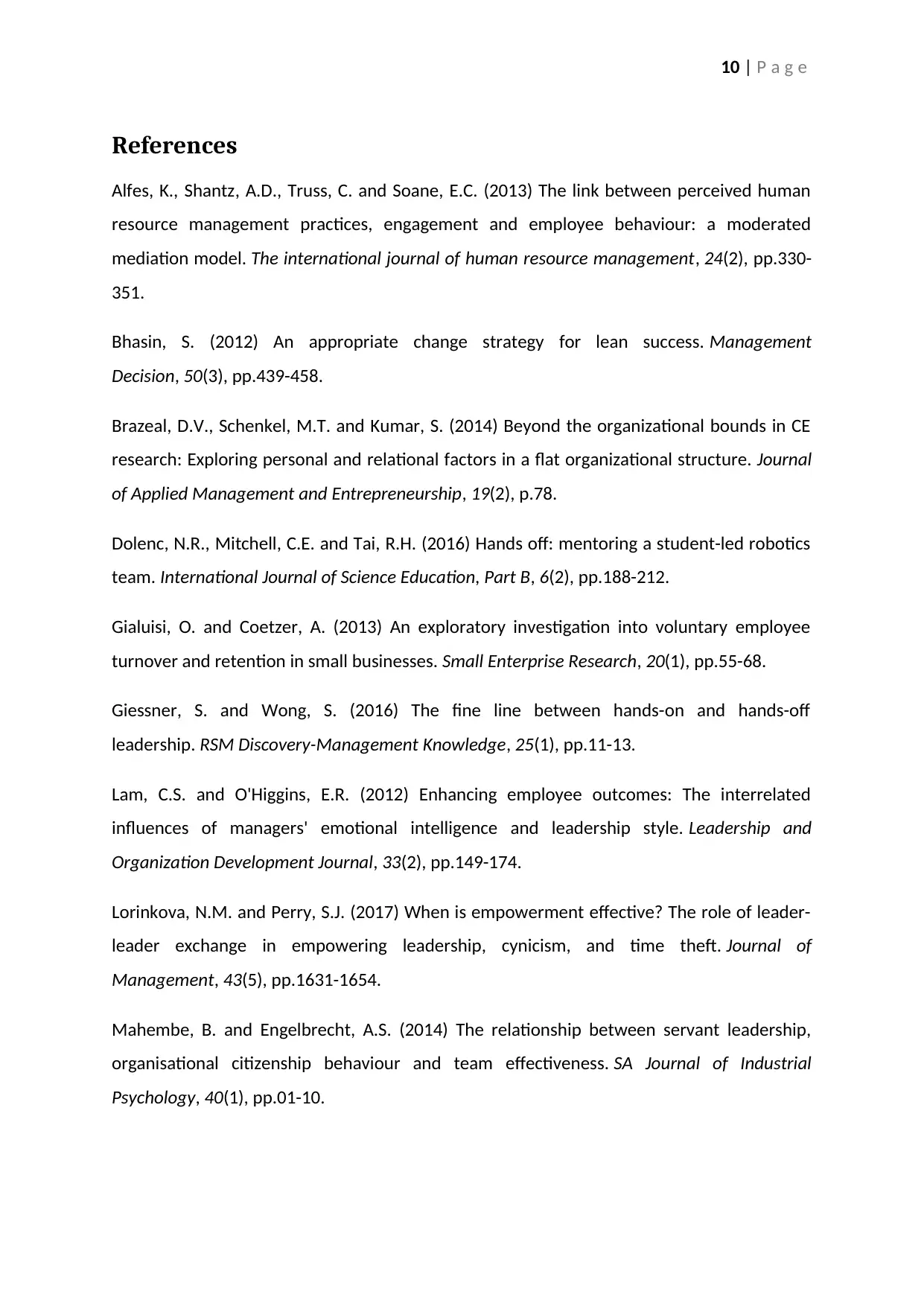
10 | P a g e
References
Alfes, K., Shantz, A.D., Truss, C. and Soane, E.C. (2013) The link between perceived human
resource management practices, engagement and employee behaviour: a moderated
mediation model. The international journal of human resource management, 24(2), pp.330-
351.
Bhasin, S. (2012) An appropriate change strategy for lean success. Management
Decision, 50(3), pp.439-458.
Brazeal, D.V., Schenkel, M.T. and Kumar, S. (2014) Beyond the organizational bounds in CE
research: Exploring personal and relational factors in a flat organizational structure. Journal
of Applied Management and Entrepreneurship, 19(2), p.78.
Dolenc, N.R., Mitchell, C.E. and Tai, R.H. (2016) Hands off: mentoring a student-led robotics
team. International Journal of Science Education, Part B, 6(2), pp.188-212.
Gialuisi, O. and Coetzer, A. (2013) An exploratory investigation into voluntary employee
turnover and retention in small businesses. Small Enterprise Research, 20(1), pp.55-68.
Giessner, S. and Wong, S. (2016) The fine line between hands-on and hands-off
leadership. RSM Discovery-Management Knowledge, 25(1), pp.11-13.
Lam, C.S. and O'Higgins, E.R. (2012) Enhancing employee outcomes: The interrelated
influences of managers' emotional intelligence and leadership style. Leadership and
Organization Development Journal, 33(2), pp.149-174.
Lorinkova, N.M. and Perry, S.J. (2017) When is empowerment effective? The role of leader-
leader exchange in empowering leadership, cynicism, and time theft. Journal of
Management, 43(5), pp.1631-1654.
Mahembe, B. and Engelbrecht, A.S. (2014) The relationship between servant leadership,
organisational citizenship behaviour and team effectiveness. SA Journal of Industrial
Psychology, 40(1), pp.01-10.
References
Alfes, K., Shantz, A.D., Truss, C. and Soane, E.C. (2013) The link between perceived human
resource management practices, engagement and employee behaviour: a moderated
mediation model. The international journal of human resource management, 24(2), pp.330-
351.
Bhasin, S. (2012) An appropriate change strategy for lean success. Management
Decision, 50(3), pp.439-458.
Brazeal, D.V., Schenkel, M.T. and Kumar, S. (2014) Beyond the organizational bounds in CE
research: Exploring personal and relational factors in a flat organizational structure. Journal
of Applied Management and Entrepreneurship, 19(2), p.78.
Dolenc, N.R., Mitchell, C.E. and Tai, R.H. (2016) Hands off: mentoring a student-led robotics
team. International Journal of Science Education, Part B, 6(2), pp.188-212.
Gialuisi, O. and Coetzer, A. (2013) An exploratory investigation into voluntary employee
turnover and retention in small businesses. Small Enterprise Research, 20(1), pp.55-68.
Giessner, S. and Wong, S. (2016) The fine line between hands-on and hands-off
leadership. RSM Discovery-Management Knowledge, 25(1), pp.11-13.
Lam, C.S. and O'Higgins, E.R. (2012) Enhancing employee outcomes: The interrelated
influences of managers' emotional intelligence and leadership style. Leadership and
Organization Development Journal, 33(2), pp.149-174.
Lorinkova, N.M. and Perry, S.J. (2017) When is empowerment effective? The role of leader-
leader exchange in empowering leadership, cynicism, and time theft. Journal of
Management, 43(5), pp.1631-1654.
Mahembe, B. and Engelbrecht, A.S. (2014) The relationship between servant leadership,
organisational citizenship behaviour and team effectiveness. SA Journal of Industrial
Psychology, 40(1), pp.01-10.
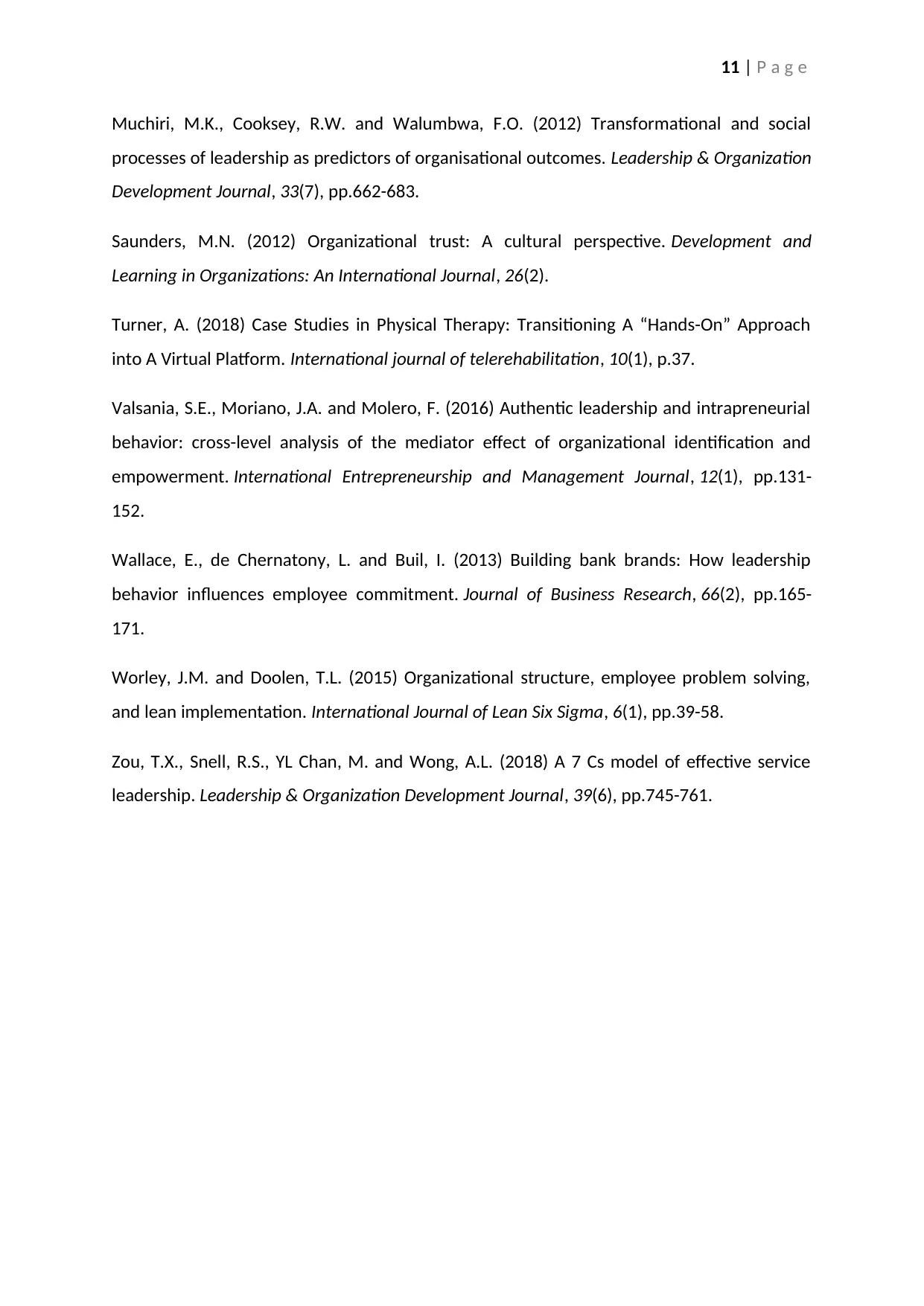
11 | P a g e
Muchiri, M.K., Cooksey, R.W. and Walumbwa, F.O. (2012) Transformational and social
processes of leadership as predictors of organisational outcomes. Leadership & Organization
Development Journal, 33(7), pp.662-683.
Saunders, M.N. (2012) Organizational trust: A cultural perspective. Development and
Learning in Organizations: An International Journal, 26(2).
Turner, A. (2018) Case Studies in Physical Therapy: Transitioning A “Hands-On” Approach
into A Virtual Platform. International journal of telerehabilitation, 10(1), p.37.
Valsania, S.E., Moriano, J.A. and Molero, F. (2016) Authentic leadership and intrapreneurial
behavior: cross-level analysis of the mediator effect of organizational identification and
empowerment. International Entrepreneurship and Management Journal, 12(1), pp.131-
152.
Wallace, E., de Chernatony, L. and Buil, I. (2013) Building bank brands: How leadership
behavior influences employee commitment. Journal of Business Research, 66(2), pp.165-
171.
Worley, J.M. and Doolen, T.L. (2015) Organizational structure, employee problem solving,
and lean implementation. International Journal of Lean Six Sigma, 6(1), pp.39-58.
Zou, T.X., Snell, R.S., YL Chan, M. and Wong, A.L. (2018) A 7 Cs model of effective service
leadership. Leadership & Organization Development Journal, 39(6), pp.745-761.
Muchiri, M.K., Cooksey, R.W. and Walumbwa, F.O. (2012) Transformational and social
processes of leadership as predictors of organisational outcomes. Leadership & Organization
Development Journal, 33(7), pp.662-683.
Saunders, M.N. (2012) Organizational trust: A cultural perspective. Development and
Learning in Organizations: An International Journal, 26(2).
Turner, A. (2018) Case Studies in Physical Therapy: Transitioning A “Hands-On” Approach
into A Virtual Platform. International journal of telerehabilitation, 10(1), p.37.
Valsania, S.E., Moriano, J.A. and Molero, F. (2016) Authentic leadership and intrapreneurial
behavior: cross-level analysis of the mediator effect of organizational identification and
empowerment. International Entrepreneurship and Management Journal, 12(1), pp.131-
152.
Wallace, E., de Chernatony, L. and Buil, I. (2013) Building bank brands: How leadership
behavior influences employee commitment. Journal of Business Research, 66(2), pp.165-
171.
Worley, J.M. and Doolen, T.L. (2015) Organizational structure, employee problem solving,
and lean implementation. International Journal of Lean Six Sigma, 6(1), pp.39-58.
Zou, T.X., Snell, R.S., YL Chan, M. and Wong, A.L. (2018) A 7 Cs model of effective service
leadership. Leadership & Organization Development Journal, 39(6), pp.745-761.
⊘ This is a preview!⊘
Do you want full access?
Subscribe today to unlock all pages.

Trusted by 1+ million students worldwide
1 out of 12
Related Documents
Your All-in-One AI-Powered Toolkit for Academic Success.
+13062052269
info@desklib.com
Available 24*7 on WhatsApp / Email
![[object Object]](/_next/static/media/star-bottom.7253800d.svg)
Unlock your academic potential
Copyright © 2020–2025 A2Z Services. All Rights Reserved. Developed and managed by ZUCOL.




